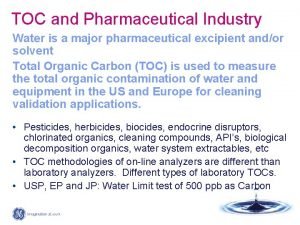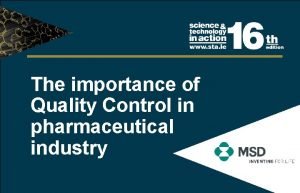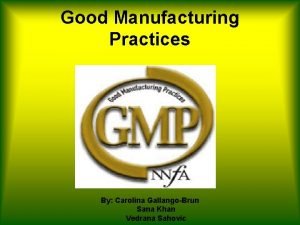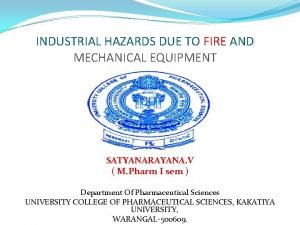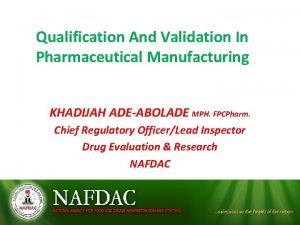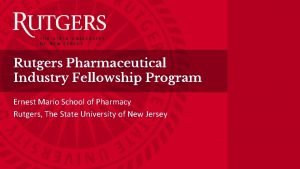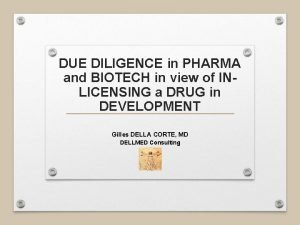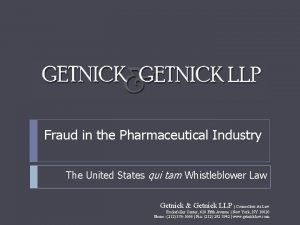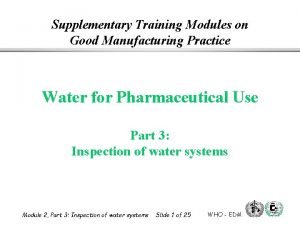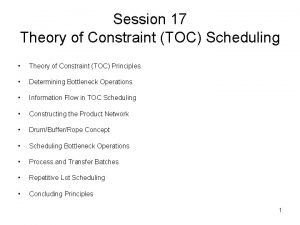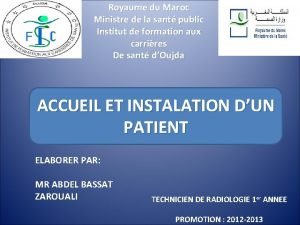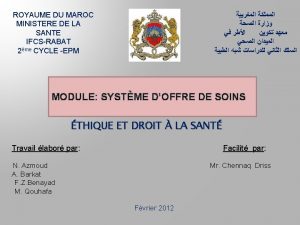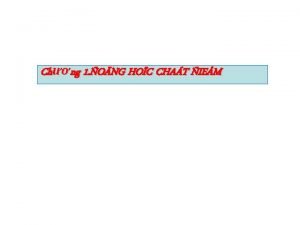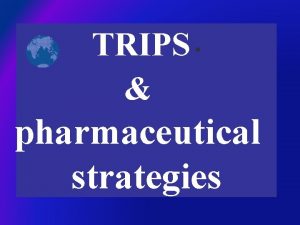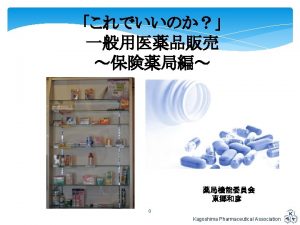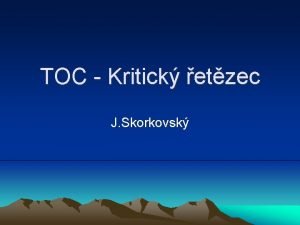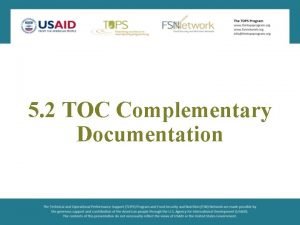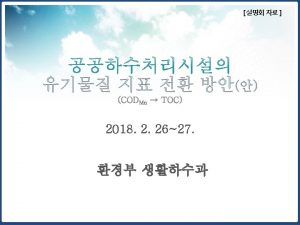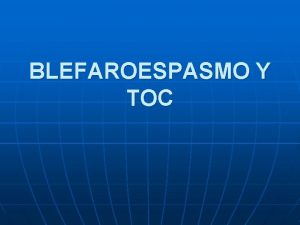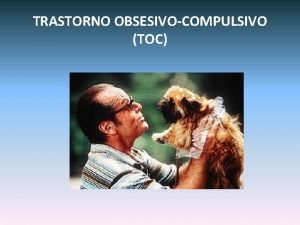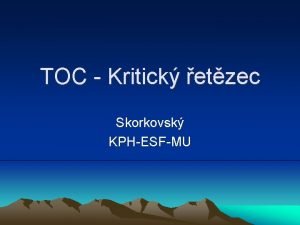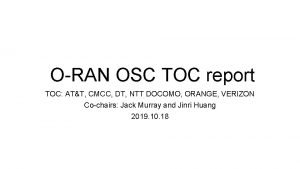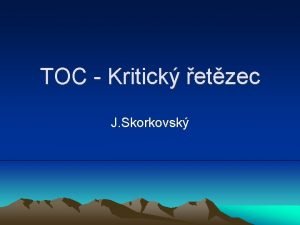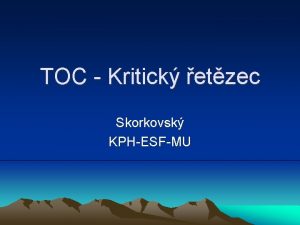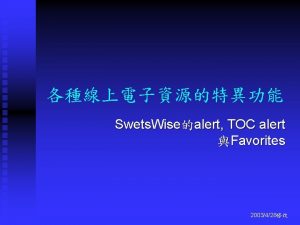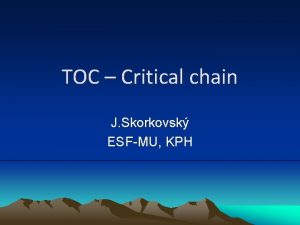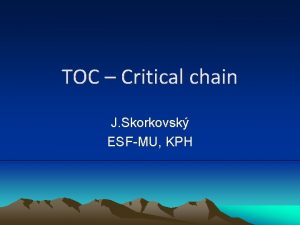TOC and Pharmaceutical Industry Water is a major



















- Slides: 19

TOC and Pharmaceutical Industry Water is a major pharmaceutical excipient and/or solvent Total Organic Carbon (TOC) is used to measure the total organic contamination of water and equipment in the US and Europe for cleaning validation applications. • Pesticides, herbicides, biocides, endocrine disruptors, chlorinated organics, cleaning compounds, API’s, biological decomposition organics, water system extractables, etc • TOC methodologies of on-line analyzers are different than laboratory analyzers. Different types of laboratory TOCs. • USP, EP and JP: Water Limit test of 500 ppb as Carbon

How is TOC used to Measure Pharmaceutical Impurities in the US, Europe, and Japan? Laboratory TOC Analysis: Release of Purified Water (PW) and Water for Injection (WFI) Cleaning validation Online TOC Analysis Routine monitoring and system trending Real-time release of PW and WFI to manufacturing Real-time online cleaning validation

USA History of Cleaning Validation 1963 GMP Regulations: "Equipment shall be maintained in a clean and orderly manner. ” 1978 c. GMP Regulations: Section 211. 67 added describing equipment cleaning and maintenance. 1993 FDA Guide to inspections for cleaning validation. 2000 ICH Q 7 2002 FDA’s Risk Based Approach, (PAT) 2004 Pharmaceutical c. GMP’s for the 21 st century: A risk based approach. 2006 FDA’s API Process Inspection Guide

“The purpose of cleaning validation is to demonstrate that a particular cleaning process will consistently clean the equipment to a predetermined limit; the sampling and analytical test methods should be scientifically sound and provide adequate scientific rationale to support the validation”. - US FDA

It’s this simple right? Well not exactly…. Batch & Clean Sample Analysis Direct (Swab) Indirect (Rinse) Product or Non-product Contact Verify Cleanliness per Acceptance Criteria

Cleaning Validation is a “Herculean” effort R&D, QA & QC Ops, PD, Engineering Identify Residue Worst Case ID & Designation TOC Analysis Selection Cleaning SOP Development Sampling Method Selection Cleaning Agent & Factors Selection MAC & Process Control Limits Sampling Site Selection Percent Recovery Studies Cleaning SOP Prep & Training Methods SOP Prep & Training Validation Team Adopted from Becky Brewer – Dober Group

Current Regulations Cleaning of Process Equipment: “Equipment and utensils shall be cleaned, maintained, and sanitized at appropriate intervals to prevent malfunctions or contamination that would alter the safety, identity, strength, quality, or purity of the drug product beyond the official or other established requirements”. - CFR 211. 67

Does USA FDA have impurities acceptance limits for cleaning validation and subsequent cleaning verification? (FDA's HUMAN DRUG CGMP NOTES (Volume 6, Number 2) June 1998. ) “FDA has always been concerned with the issue of contamination and cross contamination. Such contamination may include not only carry over from a previous product or residual cleaning solvents, but also detergents and surfactants. ”

FDA’s response-Cont. “When determining the acceptance limit, relevant factors generally include: (1) Evaluation of therapeutic dose carryover; (2) toxicity of the potential contaminant; (3) concentration of the contaminant in the rinses; (4) limit of detection of the analytical test method; and, (5) visual examination. While we suggest that these factors be considered, relying only on visual examination would not be scientifically sound. ” -Patricia L. Alcock , FDA CDER

FDA’s guidance on use of TOC for cleaning validation Can Total Organic Carbon (TOC) be an acceptable method for detecting residues of contaminants in evaluating cleaning effectiveness? (Updated 5/18/2005) Yes. Since the publication of the inspection guide on cleaning validation in 1993, a number of studies have been published to demonstrate the adequacy of TOC in measuring contaminant residues. TOC or TC can be an acceptable method for monitoring residues routinely and for cleaning validation. In order for TOC to be functionally suitable, it should first be established that a substantial amount of the contaminating material(s) is organic and contains carbon that can be oxidized under TOC test conditions. This is an important exercise because some organic compounds cannot be reliably detected using TOC use may be justified for direct surface sample testing as well as indirect (rinse water) sample testing. In either case, because TOC does not identify or distinguish among different compounds containing oxidizable carbon, any detected carbon is to be attributed to the target compound(s) for comparing with the established limit. Thus, a firm should limit 'background' carbon (i. e. , carbon from sources other than the contaminant being removed) as much as possible. If TOC samples are being held for long periods of time before analysis, a firm should verify the impact of sample holding time on accuracy and limit of quantitation.

A few of the companies Using TOC for CV:

New FDA Inspection Site Selection Scoreboard-Risk Based! Factor Category Description Examples Product Properties of drug Quality deficiencies Past product recalls Toxicity levels Facility Potential quality risks High Risk of cross Lack quality systems contamination Poor c. GMP compliance history Process control deviations Multi-product process No process controls to assure quality Reference: FDA’s IOM (Inspectors Operations Manua

Newest FDA Focus: > More focus on process and process control > More evaluation of your process capabilities of the cleaning validation program, (and all systems) to mitigate risk The “Big” Three in Audits & Inspections Cleaning Validation Impact 1) 2) 3) Non-Conformances/Deviations & Investigations CAPA’s (Corrective Action Preventative Action) Change Control

Compound Specific vs. Organic Carbon Specific Methods Compound Specific assay will allow for quantitative detection of a single ingredient Organic Carbon Specific will allow for detection of all organic components without speciation of those components Compound SPECIFIC Methods: • HPLC (UV and MS) • NIR • IMS • ELISA Used together can be effective Useful for R&D and Method Validation Organic Carbon SPECIFIC Method: • TOC • NPOC Useful for R&D and Manufacturing Validation

Comparison of HPLC to TOC HPLC Organic Specific Need Many methods Sensitive Detect H 2 O Insolubles Accepted Practice TOC Specific to all Organic C One method for all Sensitive (30 ppt) H 20 Insoluble organics? Becoming well accepted Slide adopted by Andy Walsh, Hoffman La Roche

Detection of Water Insoluble Compounds? HPLC vs. TOC HPLC can detect any compound since you can use whatever solvent you want for your direct and indirect samples. So this must mean that TOC can only use water as a solvent, because TOC can only be used to detect water soluble compounds? (hydrophilic or polar compounds only? )

Recovery of Insolubles in Water? Slide adopted by Andy Walsh, Hoffman La Roche

Recovery Can be Improved by Modifying p. H Adjusting the p. H of the sample can improve recoveries. Slide adopted by Andy Walsh, Hoffman La Roche

Cleaning Validation TOC Analyzers Distribution in USA and Europe UV-Persulfate & NDIR: 15% Combustion & NDIR: 10% UV-Persulfate & NDIR: 18% Combustion & NDIR: 23% UV-Persulfate & MC 75% USA UV-Persulfate & MC 65% Europe
 Clochette saint nicolas
Clochette saint nicolas Quand le ciel est bleu mon garçon
Quand le ciel est bleu mon garçon Toc in pharmaceutical industry
Toc in pharmaceutical industry Water and water and water water
Water and water and water water Importance of quality in pharmaceutical industry
Importance of quality in pharmaceutical industry Good manufacturing practices in pharmaceutical industry
Good manufacturing practices in pharmaceutical industry Mechanical hazards in industry
Mechanical hazards in industry Satisfaction mv
Satisfaction mv Concurrent validation in pharmaceutical industry
Concurrent validation in pharmaceutical industry Enterprise risk management pharmaceutical industry
Enterprise risk management pharmaceutical industry Rutgers pharmacy fellowship salary
Rutgers pharmacy fellowship salary Pharmaceutical due diligence checklist
Pharmaceutical due diligence checklist Fraud in pharmaceutical industry
Fraud in pharmaceutical industry Pharmaceutical water system training
Pharmaceutical water system training Toc meaning school
Toc meaning school Toc mérés
Toc mérés Toc scheduling
Toc scheduling Toc doc maroc
Toc doc maroc Toc doc maroc
Toc doc maroc Vận tốc góc
Vận tốc góc


